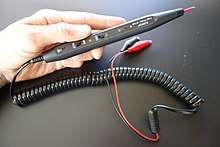Logic probe

A logic probe is a hand-held test probe used for analyzing and troubleshooting the logical states (boolean 0 or 1) of a digital circuit. While most are powered by the circuit under test, some devices use batteries. They can be used on either TTL (transistor-transistor logic) or CMOS (complementary metal-oxide semiconductor) integrated circuit devices.
The Logic Probe,[2][3] was invented by Gary Gordon in 1968, then employed by Hewlett-Packard.
There are typically one or more LEDs on the probe's body.
- an LED to indicate a high (1) logic state.
- an LED to indicate a low (0) logic state.
- an LED to indicate changing back and forth between low and high states. The pulse-detecting electronics usually has a pulse-stretcher circuit so that even very short pulses become visible on the LED.
A control on the logic probe allows either the capture and storage of a single event or continuous running.
When the logic probe is either connected to an invalid logic level (a fault condition or a tri-stated output) or not connected at all, none of the LEDs light up.
Another control on the logic probe allow selection of either TTL or CMOS family logic. This is required as these families have different thresholds for the logic-high (VIH) and logic-low (VIL) circuit voltages.
Some logic probes have a separate audible tone for each of the logical states. An oscillating signal causes the probe to alternate between high-state and low-state tones.
A logic probe is a low cost, versatile and convenient digital test instrument, but can test only a single signal at a time. When many logic levels need to be observed or recorded simultaneously, a logic analyzer is used.
References
- ↑ Elenco LP-560 logic probe
- ↑ "IC Logic Checkout Simplified" (PDF). HP Journal. No. 6. 1969. pp. 14–16.
- ↑ US 3543154, "Logic Probe"
External links
| Wikimedia Commons has media related to Logic probes. |